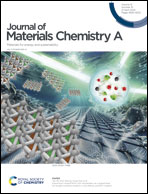Modulation of active surface sites on Ni–Fe–S by the dynamic hydrogen bubble template method for energy-saving hydrogen production†
Abstract
A 3-D porous structure of Ni–Fe–S nanosheets was created using a dynamic hydrogen bubble template (DHBT), which promotes active site exposure, on a nickel foam substrate as an efficient electrode for production of hydrogen through electrochemical splitting assisted by the urea oxidation reaction. In a DHBT, high applied current densities result in the reduction of H+ ions alongside the Ni–Fe–S, forming H2. These H2 bubbles block the surface and force the remaining ions to electrodeposit between the bubbles, resulting in a porous structure. The electrocatalyst exhibited remarkable performance for both the hydrogen evolution reaction (HER) and urea oxidation reaction (UOR). The parameters investigated in this study included applied current density, duration time, and FeSO4 concentration. The electrocatalyst synthesized at 5 A cm−2, 10 s, and 0.1 M FeSO4 demonstrated the highest catalytic activity, resulting in values of 85 and 173 mV vs. RHE for the HER and 1.26 and 1.30 V vs. RHE for the UOR to reach 10 and 100 mA cm−2, respectively. In the two electrode system of Ni–Fe–S//Ni–Fe–S, it only requires a low voltage of 1.337 V vs. RHE to launch a current density of 10 mA cm−2. The enhanced activity is thought to stem from charge separation between the negatively charged S and the positively charged Ni and Fe, as well as the larger electrochemical active surface area (ECSA) and increased porosity. An insignificant shift in the potential was observed over a duration of 50 h at 100 mA cm−2, indicating exceptional electrocatalytic stability for both the HER and UOR. This study presents the impact of the utilization of the UOR on enhancing the electrocatalytic performance of hydrogen production.

- This article is part of the themed collection: Catalysis showcase


 Please wait while we load your content...
Please wait while we load your content...